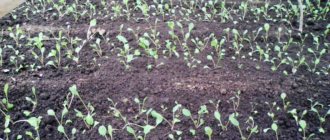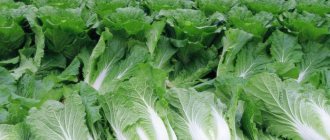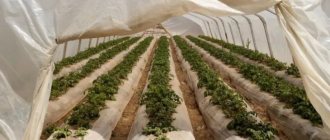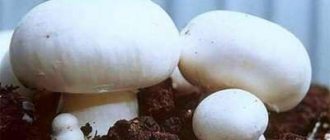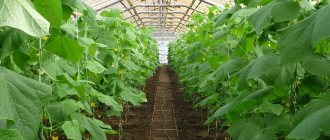Cauliflower got its name because it is not the leaves of this crop that are eaten, but its inflorescences. Although the heads come in orange, green and even purple, the most popular varieties remain in white shades. The article will discuss growing cauliflower in a greenhouse.
Features of growing cauliflower in greenhouse conditions
The crop we are interested in is an annual one; it produces head-shaped fruits in one season. It consists of many shoots tightly pressed to each other. During the growth of the head, the development of seed shoots is visible. They join together in clusters, after which pods begin to form.
Cauliflower grows well in equinox conditions. The plant does not require a lot of heat. The optimal temperature is considered to be between +16–20 °C.
Important! If the greenhouse is below +15 degrees, the crop forks will be poorly developed and very small.
Cauliflower takes quite a long time to ripen. Delivery of a harvest ready for harvest can take a month. This is twice as much as in the case of white cabbage.
Many complain that this crop produces poor yields and is capricious. Such situations only happen when the rules for growing seedlings and caring for the plant are not followed. It is enough to understand some of the nuances of cultivation in order to always get a rich harvest of this agricultural crop.
Description of the plant
This annual plant has a root system located close to the surface of the earth. The height of the stem reaches 70 centimeters and has a cylindrical shape. The leaf mass can be arranged in three ways
- horizontally;
- in a spiral;
- obliquely up.
They can sit whole or be divided; the petioles sometimes grow up to 40 centimeters. The color of the leaves is all shades of green.
The heads of the crop - lush flower stalks - are used for food. Only inflorescences that are at the embryonic stage of their development are suitable for consumption. They are:
- snow-white;
- yellow;
- creamy;
- soft green;
- dark green;
- purple.
The inflorescences technically mature in 2 to 3 months. The fruits are multi-seeded pods that grow to almost 9 centimeters. Their shape is cylindrical or slightly compressed. This healthy vegetable is grown by planting seeds. You can use the seedless or seedling method.
Varieties for greenhouses
You can grow cauliflower in open ground, but it is easier to create a favorable environment for a good harvest in a greenhouse. To choose a variety, it is advisable to consult with experienced gardeners or read their reviews. The following varieties rightfully deserve appreciation:
- Alpha;
- Goat - Dereza;
- Express;
- Blizzard;
- White Castle;
- Yako;
- Domestic;
- Autumn Giant;
- Regent.
It is better to plant mid-late and late varieties in the greenhouse, which significantly reduces their ripening period.
Transplanting seedlings to the garden bed
The technology for growing cauliflower in open ground includes several points.
Landing dates
Early varieties, which were sown in late February, are planted in beds from late April to mid-May. If a mid-season variety is planted, then it is planted in open ground from late May to mid-June. Late varieties of seedlings should be planted a month after sowing.
Seven days before planting the seedlings, you need to feed them with a solution to protect the tender shoots from a sudden drop in temperature. Three grams of superphosphate are diluted in a liter of water, and then another three grams of potassium chloride are added.
Popular: What to do when rehabilitating the roots of a cactus when rotting
Soil for cauliflower
Landing on cloudy but warm days. The beds are placed in sunny areas. It would be nice if a year earlier the harvest of legumes, carrots, garlic or potatoes was harvested at this place. The predecessors should not be radishes, beets, other varieties of cabbage or tomatoes. After them, you can plant cauliflower only after a few years.
The bed should be dug up in the fall. If the soil is acidic, lime is added to it. With the onset of spring, you need to add a bucket of humus to the prepared holes. Compost works well. You can add one pinch of urea and two tablespoons of superphosphates to it. Mix everything thoroughly with black soil.
How to plant
Make holes at a distance of 35 centimeters from each other. The distance between the beds should be at least 50 centimeters. The seedlings are deepened to the first leaves, sprinkled with soil mixture and watered.
When planting seedlings before the beginning of May, it is better to cover them for several days with burlap or cellophane film. This will make it possible to protect plants from pest attacks and late frosts.
In the southern regions, it is often practiced to sow seeds directly into open ground. They germinate well even if the air temperature is 2-4C. However, in the northern regions this method is not suitable.
Plant care
If cauliflower is grown in the middle zone, it requires good care. In this case, you can harvest a large harvest of elastic inflorescences. Caring for cabbage includes regular loosening of the soil, weeding, preventive treatment, hilling, and watering.
The soil around the sprouts is loosened when the ground is wet. This is usually done after rains or watering.
How is watering done?
The plant needs to be watered regularly and abundantly. This must be done once every 8 days. After planting the seedlings, for the first time you will have to water twice a week.
If the weather is not too dry, water consumption is 8 liters per square meter. As cauliflower begins to grow, it will need more moisture. Then the water consumption is increased in proportion to the growth of the crop.
We must not allow a “swamp” to form in the beds. This can cause a fungal infection. If spring and summer are rainy, the vegetable can be left without watering at all. Regulate the need for soil moisture based on its condition.
To protect the inflorescences from dark spots and retain moisture in them, cover the heads with leaves. Several leaves need to be carefully folded up.
Planting methods
It is better not to plant cabbage seeds in the ground, since temperature fluctuations negatively affect the growth and fruiting of the vegetable. The best method of planting is by seedlings, for which the seeds (after preliminary calibration and disinfection) are planted in peat cups with well-fertilized soil.
REFERENCE: For disinfection, use: a solution of potassium permanganate, an infusion of garlic, or simply warm the seeds in warm water.
Before the seeds germinate, the seedlings are kept at a temperature of 20 degrees; after the sprouts appear, the temperature is reduced to + 10.
By the time of planting in the ground, the sprouts have 3-5 true leaves. Plant, deepen to the first leaf and water well.
IMPORTANT! Cabbage does not like acidic soil. You can normalize acidity using ash, lime or chalk.
Growing crops in stages
Sowing seeds for seedlings
Planting material requires careful preparation. The following operations are mandatory:
- Sorting and sizing (by size). The largest material is selected.
- Treating the seeds with garlic infusion or another non-toxic solution (disinfection) and then heating them in a warm liquid (ordinary clean water).
- Soaking the material. Performed in formulations rich in microelements.
Seeds are planted in peat cups or pots or in cloth bags. A thin layer of expanded clay is placed at the bottom of the containers. It is needed to ensure quality drainage. Store-bought soil is poured on top. You can make soil yourself using:
- 5% sand;
- 30% peat;
- 35% regular garden soil;
- 30% black soil.
The seeds are embedded in the soil to a depth of 5–6 mm and covered with sand on top. The latter minimizes the risk of plant damage by fungus. The containers are covered with film and placed in a warm room.
10–12 days after mass shoots of cabbage of the selected variety appear, the following is produced:
- Feeding seedlings. Use factory fertilizer or a solution of ammonium (5 g) and potassium nitrate (10 g) dissolved in 10 liters of water.
- Picking seedlings.
Every 3–4 days, seedlings are sprayed with boric acid (weak aqueous solution) using a spray bottle. Repeated feeding is often performed.
Transplanting into a greenhouse
Transplantation of seedlings into a greenhouse should be carried out immediately after the formation of 5 leaves. This process cannot be delayed, since an overexposed crop may not take root in a new place.
Transplantation is carried out into previously prepared holes. Their desired dimensions are 30 by 70 cm. Kemir or other complex fertilizer, humus and ash (wood) are poured into the bottom of these holes.
The seedlings are buried down to the first leaf and immediately watered. In the first days after transplantation, if it is cold outside, you can additionally cover the bushes with film or any non-woven material.
Features of care
Cauliflower is capricious and prefers a certain temperature regime in the range from 16 to 22 degrees.
To prevent cabbage from blooming prematurely, you need to shade the seedlings. She does not like direct sunlight, especially during the flowering period. Therefore, the inflorescences need to be shaded with broken leaves.
It is worth fertilizing the beds 10 - 12 days after planting, and then every 14 days until the ovary appears. Preferably use:
- nitrophoska solution;
- mullein;
- bird droppings;
- ammonium nitrate;
- superphosphate;
- urea.
This crop is sensitive to moisture. Seedlings need to be watered every 2 - 3 days. And when the plants grow, watering once a week is enough. The greenhouse should be regularly ventilated so that moist air does not stagnate. This can lead to fungal infections and rot.
Lighting
It is possible to get a good harvest only if there is maximum illumination of the plantings in the greenhouse. With a lack of light, the plant has poor resistance to pests and diseases and stretches out.
Seedlings are illuminated using fluorescent lamps. For better effect, reflective screens can be used.
Watering the crop
The soil in the greenhouse needs to be moistened regularly. This is very important at the time when the head begins to form. If there is a lack of moisture, the harvest will significantly deteriorate and the ripening time will increase.
Nuance! Cauliflower grows best at around 80% humidity.
Fertilizer application
The crop is fertilized with nitrophoska. Fertilizer is applied after the true leaves appear.
After 10 days, another feeding is carried out. It is performed with a mixture consisting of the following components:
- manganese sulfate;
- nitrate (ammonium nitrate);
- potassium sulfate;
- copper sulfate;
- superphosphate;
- boric acid.
You can also carry out foliar feeding using an aqueous solution of molybdenum ammonium and boric acid.
Features and characteristics of culture
Cauliflower is considered a cold-resistant vegetable crop. She is one year old. It is grown for its head formed by shortened flowering stems. Its tissue contains fiber, so the vegetable benefits patients suffering from digestive problems.
The pulp contains:
- dry matter - 10.5%;
- carbohydrates - 5.4%;
- proteins - 2.6%;
- vitamins;
- minerals (potassium, calcium, iron, magnesium).
A plant grown from seeds has a taproot type. When growing cauliflower through seedlings, a fibrous root system is formed. The crop has a herbaceous stem, which becomes coarser towards the end of the growing season. The level of cold resistance is determined by the variety. Early ripening varieties cannot withstand frosts down to -3 °C during the formation of inflorescences; late varieties are more cold-resistant. They tolerate cold temperatures down to -5 °C.
Diseases and pests
Cabbage has many diseases, the most common of which are:
- white rot;
- clubroot;
- fusarium;
- blackleg;
- downy mildew;
- gray rot;
- mosaic;
- mucous bacteriosis;
- black rot.
REFERENCE: Mosaic is a viral disease. It cannot be treated and leads to the death of the entire crop. Carried by insects and gardening tools. Dangerous for the entire garden.
In addition to diseases, pests poison the life of a gardener; their list is also impressive:
- slugs;
- caterpillars;
- cabbage aphid;
- cruciferous flea beetles;
- cabbage fly.
Fungal infections are successfully treated with Fitosporin. There are a lot of folk remedies against pests. But the best way to fight is prevention. Removing weeds in a timely manner, monitoring humidity, digging up the soil in the fall and applying all the necessary fertilizers - this is what will help increase the yield and reduce the risk of diseases and pests.
Cultivation in open area
In a country garden, a bed for cauliflower is made in those places where certain vegetables grew. Good predecessors for spring planting:
- onion;
- tomatoes;
- potato;
- cucumbers
In summer, cauliflower is planted after lettuce, spinach, and other early greens. Crop rotation is the basis of agricultural technology. The harvest largely depends on it.
Setting the stage
The soil is dealt with immediately after harvesting the predecessor crop. When digging, add any organic fertilizer (peat, compost, humus). Approximate consumption - 5 kg/m². Once every 7 years, the acidic soil is limed, and gypsum is added to the solonetz soil.
During autumn digging, mineral fertilizers necessary to feed cauliflower are applied:
- superphosphate - 1 kg;
- potassium sulfate - 0.5 kg.
Fertilizer consumption is given for a ridge with an area of 10 m². Nitrogen fertilizer (ammonium nitrate) is applied in the spring before planting cauliflower. Consumption - 0.5 kg per 10 m².
Sowing seeds and planting seedlings
Seeds are subjected to heat treatment before sowing. They are poured into a fabric bag. First, immerse in hot water for 10 minutes, then in cold water for 1 minute. Keep the seed in the refrigerator for 10 hours.
Seeds are sown in a common container or in separate containers. They are buried by 0.5 cm. When 5-6 leaves appear, the cauliflower seedlings are transplanted into the garden. They are covered from the sun for a week.
Irrigation and fertilization of cabbage bushes
The volume and frequency of irrigation are affected by weather conditions and the amount of precipitation. At the beginning of the growing season, cauliflower needs less water than during the formation of inflorescences:
- first half of the growing season - 30 l/m²;
- second half of the growing season - 40 l/m².
During the season, fertilizers are applied to cauliflower 2-3 times. The interval between them is 2-3 weeks. At the beginning of the growing season, nitrogen fertilizers (25 g/m²) are used. During the period of inflorescence ripening, cabbage is fertilized with phosphorus-potassium fertilizers (30 g/m²).
When to Hill Cauliflower
For those who grow cauliflower for the first time, the question arises whether and when to hill it. Loosen the soil in the rows and around the plants all summer. At the same time, cut off the weeds. Adhere to the following scheme:
- the first loosening to a depth of 4 cm a week after transplanting the seedlings;
- all subsequent ones - after watering to a depth of 10 cm.
Hill up the cauliflower once before closing the rows.
Caring for unopened inflorescences
Cauliflower can be grown if its heads have not formed before frost. Take plants with a sufficient number of leaves (at least 14 pieces) and heads of at least 2 cm.
The plants are dug up with a lump of earth and transferred to the basement. Place them in a container and cover them with soil. Care during growing:
- maintain soil and air moisture;
- remove dried leaves.
See also
What to do if ants eat cabbage, and what are the best ways to get rid of it?
Read
| Air temperature | Growing time (days) |
| 13°C | 20 |
| 5 °C | 50 |
| 1 °C | 120 |
Protection from diseases and pests
Controlling diseases and pests is easy. At the first symptoms of fungus, the plant is treated with Fitosporin; it does not harm the inflorescences.
Burdock infusion copes with other diseases and insects. Burdock leaves are placed in a tank and filled with plain water, wait a day. The resulting solution is sprayed on all plantings and watered directly under the roots.
If you don’t want to suffer with burdock, you can purchase the ready-made Enterobacterin mixture. The rules for its use are indicated on the packaging of the drug.
Pest Control
The crop may suffer from fungal diseases. If signs of fungus are observed, then it is necessary to treat the seedlings with a special preparation “Fitosporin”. The drug is able to fight the pathogen directly. Caterpillars of cabbage whites and cabbage cutworms are also dangerous to cabbage. To combat such a parasite, you need to use the biological product “Enterobacterin”. An infusion of burdock leaves is considered to be an effective remedy.
To prepare the infusion you will need:
- 1/3 of a bucket of burdock leaves;
- water.
The infusion should stand for about a day.
Harvest
Ripe heads of cabbage are cut with 4 leaves and a small piece of stem. Unripe ones can be brought to the required condition using a simple scheme:
- the bush is dug up by the roots;
- transferred to the cellar;
- A thin layer of soil is poured on top of the plant.
With proper watering, the cabbage will ripen and increase its weight by 300–500 g. The same result is achieved by hanging the cut bushes with their roots up.
Cabbage is stored in cellars for 110–120 days. In the refrigerator, it does not lose its taste characteristics and does not deteriorate for 50 days.
If you divide the forks into inflorescences, pour water over them, dry them, remove all rotten fragments, place it in a bag and put it in the freezer of the refrigerator, it will easily overwinter. And you can please yourself with fresh vegetables without waiting for a new harvest.
Harvest and storage
If you miss the deadline for harvesting a capricious crop, it will begin to deteriorate. Early ripening varieties ripen in 60–90 days, so the heads can be collected as early as late June - early July. The growing season of mid-season varieties is 100-130 days, the heads ripen from mid-July. And late ones - 5 months in advance, so you shouldn’t harvest cabbage before the end of August - beginning of September.
The harvest must be harvested correctly:
- cut off the inflorescences when they grow to 100–120 mm in diameter;
- ripe specimens are not recommended to be left on the plant; they must be removed immediately;
- the heads are cut off along with a pair of lower leaves. For better storage, the plant is dug up along with its roots;
- The harvested crop is placed in a dark and cool place. If you leave the heads in the sun, they will begin to wilt and lose nutritional value.
Ways to preserve the harvest:
- mature heads of cabbage are placed in boxes and put away in a place where the humidity is 95% and the temperature is 0–2°C. This way the crop can be stored for about 2 months;
- if you create the same conditions and hang the cabbage upside down, it will not spoil for about 3–4 months;
- transplanting into a container with soil is a labor-intensive process. But cabbage can be stored this way for 1–4 months. The bushes are dug up with roots and planted in a box, sprinkled with earth right down to the leaves. The room should be completely dark. If light penetrates here, then the boxes are covered with any opaque fabric;
- vegetables can be wrapped in cling film and sent to the freshness zone of the refrigerator;
- Cauliflower can only be stored frozen for a whole year. The heads of cabbage are disassembled into small parts in advance, washed, dried and frozen.
What things are important to grow cabbage?
As soon as the first inflorescences appear on the cabbage, it is advisable to shade the fruits. You should not expose the crop to the scorching rays of the sun. They can cause great harm to the plant. The head will darken even if it is covered with leaves.
. Even if the alarm is false, it will not harm the bushes. At the very end of the season, they don’t take risks. The cold may come very soon, but the cabbage will not yet ripen. It is advisable to safely use the growing method in order to obtain the desired result.
. For this, seedling and non-seedling methods are used. The first is suitable for almost all regions. To obtain good material for cultivating it in the ground in the summer, you should try at the initial stage. To properly grow a crop, you need to properly prepare the land and care for the seedlings during their growth.
When and how to transplant seedlings into open ground
Cauliflower quickly adapts to new conditions if you choose the right place and maintain the distance between seedlings.
Choosing a location: taking into account the rules of crop rotation
In order for the seedlings to have enough lighting and nutrition, it is necessary to plant them in a sunny meadow, protected from drafts. The fertile composition of the soil should be at a depth of up to 40 cm. It is best to plant vegetables in a bed where cucumbers, legumes, onions, garlic, potatoes, and green manure previously grew.
Preparation of beds and placement scheme
When forming a bed for this agricultural crop, it is worth considering that the distance between early-ripening plants should be 30×60 cm. And for late-ripening species, these parameters need to be increased by 10 cm. Preparation of the bed involves adding 1 square meter. m of soil 1 bucket of humus and 1 tbsp. l. nitrophoska.
Direct drop off
The step-by-step process of planting seedlings in open areas is as follows:
- In the prepared area, you need to make holes in accordance with the size of the plant root system.
- Add a handful of humus to each hole.
- Add wood ash (1 tbsp per hole) and mix with soil.
- Moisten the soil and plant the seedling.
- Mulch with humus and compost.
- If possible, it is necessary to darken young plants for 1–2 days.
Seed selection and planting
The size of the seeds alone can determine the quality of the future cabbage harvest. When choosing seeds, pay attention to the fact that the larger the seeds, the better. To increase germination and disinfection, it is recommended to treat cabbage seeds before sowing in the ground.
First, it is better to immerse them in heated water up to 50 degrees for 20 minutes, after which they should be soaked for about 10 hours in a nutrient solution. It must be prepared from manganese sulfate (0.5 g), methylene blue (0.3 g), sulfur sulfate (0.3 g), boric acid (0.3 g) and a liter of water.
After processing, the seeds should be planted in separate pots or small containers. For cabbage, you should prepare a soil mixture from the following components: peat (6 parts), plus turf soil (1.5 parts), plus humus (2 parts), plus mullein (0.5 parts). You also need to immediately add saltpeter, potassium chloride and superphosphate to the ground.
In four to six days, shoots will appear, and in eight to twelve days the first leaf will begin to form. Further development of the leaves depends on the intensity of lighting, so it is advisable to “add light” to the cabbage seedlings.
What cabbage diseases prevent the crop from growing?
– fungi.
If their signs are present on the leaves, it is worth urgently treating them with “Fitosporin”, which perfectly eliminates the enemy without harming the inflorescences.
. Therefore, the main defense should be deployed against these insects, otherwise you will not get a rich harvest. The drug “Enterobacterin” will help, but burdock tincture is the safest. Place fresh burdock leaves in a bucket, pour in and leave for 24 hours. Watering is carried out at the root and the area is sprayed.
Much depends on the right soil
- means saturating the soil with phosphorus, potassium fertilizer and boron with lime. The application of nitrogen should be limited. Cauliflower needs a soil acidity of PH5:5. There are no restrictions on the composition, but the cultivation of cauliflower should be carried out in soil where there are no or minimal impurities of harmful substances. It is important to saturate the soil with fertilizers and provide high-quality watering. The most suitable soil composition for this crop is chernozem, medium loamy soil.
It’s good if, before planting such a crop, the following grew in the soil:
- Tomatoes;
- Potato;
- Beet;
- Beans;
- Onion.
“lived”: radishes and related crops. It is permissible to cultivate vegetables in one place for no more than 3 years. Later, harmful microorganisms may accumulate in the main part of the soil.
Sow seeds in open black soil in early May. The depth of planting cabbage seeds is no more than 2 cm. The soil must first be well moistened. The first shoots can be expected in July.
